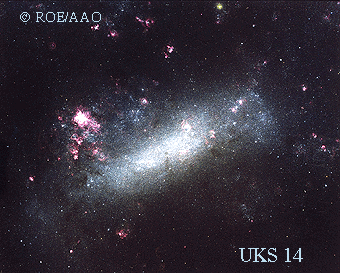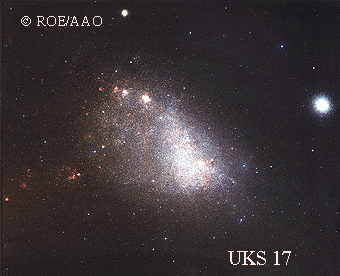The Galactic census project
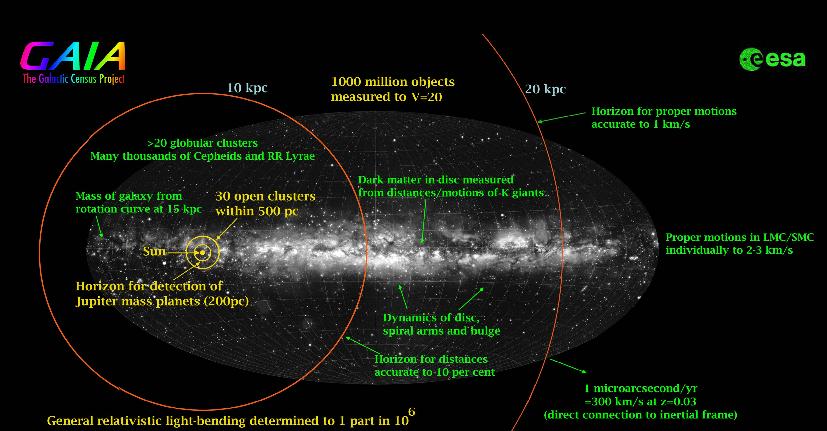
GAIA is a Cornerstone Mission
within the ESA Horizon 2000+ science plan, to fly circa 2011
GAIA will measure distances
and velocities of more than a billion stars, quasars and compact galaxies
The basic GAIA data will
be
-
parallaxes
-
proper motions
-
radial velocities
-
multiband photometry and low
resolution spectrophotometry
For several hundred million
stars, GAIA will measure 3-D positions and 3-D velocities within the Galaxy
and the local group.
A complete catalog: All the
stars will be detected on board during the mission, rather than being pre-specified
as with Hipparcos.
Main Science Issues:
-
the formation and evolution
of the Galaxy
-
Galactic mass distribution
-
stellar luminosity and mass
function in different environments
-
dynamics of the Local Group
Galaxies
-
the occurrence and statistics
of planetary systems
-
the luminosity of distance indicators
(e.g. Cepheids, RR Lyraes, PN etc)
Background
-
In 1992, ESA decided on
a series of missions called Horizon 2000+ at the level of "cornerstone
missions"
-
Interferometry in the
optical, infrared or millimetre wavebands was considered an important
next major step. Following on from the success of the first space-based
dedicated astrometric project, Hipparcos, the committee recommended "that
ESA initiate a Cornerstone-level programme in interferometry for use as
an observatory open to the wide community. The first aim [of which] is
to perform astrometric observations at the 10 microarcsec level."
-
100 times better astrometry
than Hipparcos (which had managed 1 milliarcsec)
-
At the time, interferometry
seemed the best way to get to 10 microarcsec, but the design of GAIA (Global
astrometric interferometer for astrophysics) has evolved into an imaging
telescope.
Design
-
GAIA will be parked at a Lagrangian
point (Earth-Moon) about 1.5 million km from Earth.
-
6 months will be required to
get to the Lagrangian point, then 4.5 years will be used on the mission.
-
Data transfer rate from such
a distance is an important physical limit to the design. Expected to be
10 Mbyte/sec. 100 TeraByte data base after 5 years
-
Only one ground station implies
that a lot of data will be stored on board for later transmission
(cheaper than having extra ground stations). Transmission from a phased
array behind the solar shield
-
Current Proposed Launch 2011.
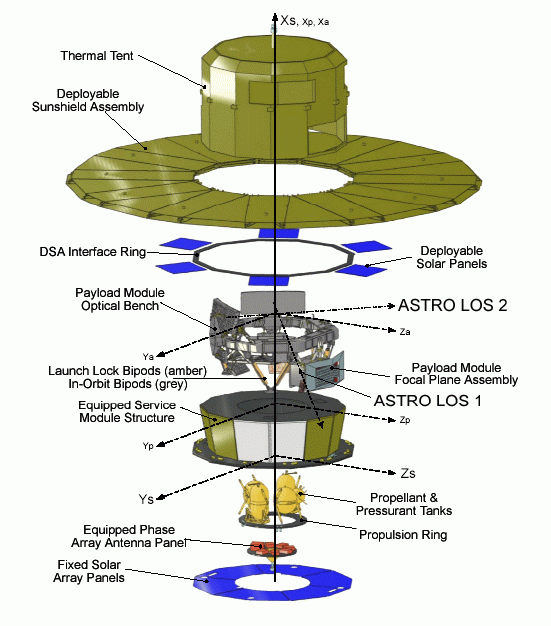
-
Schematically GAIA breaks down
into two telescopes which are mounted on a very rigid ring.
-
These telescopes
have approx 1.4 x 0.5 meter appertures.
-
A solar shield is required to
shade the ring assembly : this must be kept at the same temperature (to
within milliKelvins) in order to maintain a constant angle between the
mirrors.
-
The satellite spins slowly so
that any given region of sky passes several hundred times through the fields-of
view.
-
All objects pass the sky mappers
(70x60 cm CCD array --- the "Silicon carpet"). These CCDs are clocked
at the scan rate so that a continuous strip of sky is measured. Pixels
are 9x27 micometers.
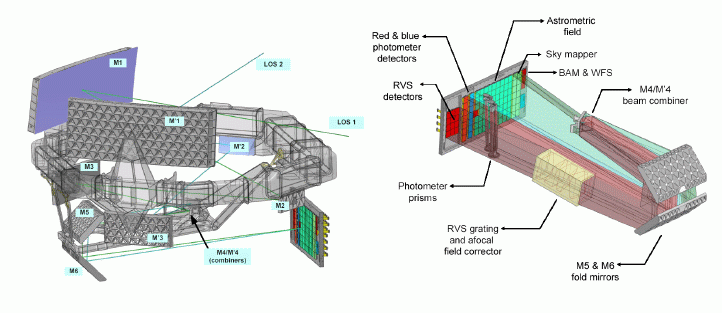
-
Scanning is at 120"/sec, which
is much too fast to read out all the CCDs. Windows around each object will
be read and summed for transmission to the ground. (This will give microarcsec
resolution images of many galaxies in addition to the stars).
-
Unobstructed diffraction limited
field-of-view is 0.85 x 0.66 degrees
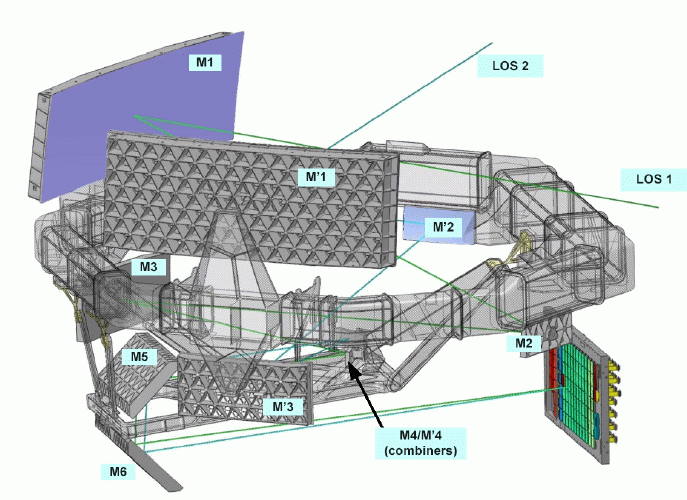
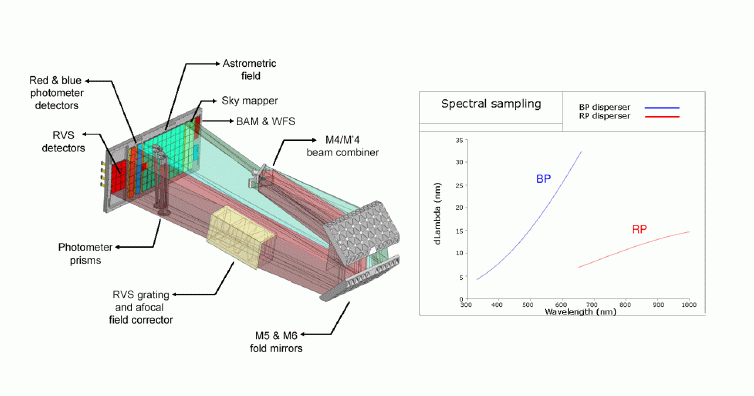
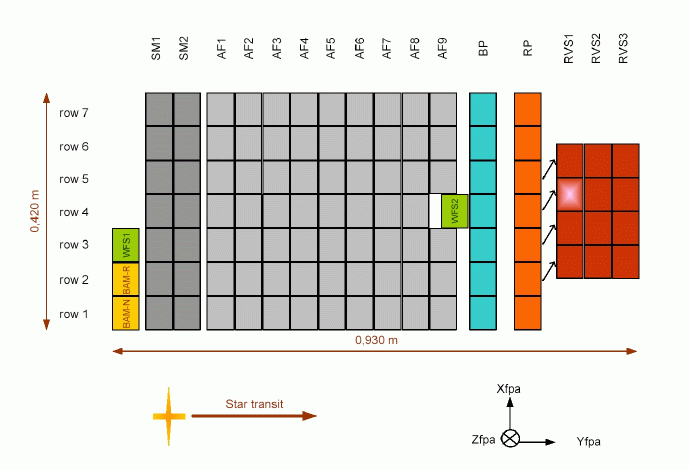
-- grey CCDs : objects are
detected and approximate positions recorded
-- light grey CCDs : (x,y) positions
measured accurately
-- blue and red CCDs : photometry
is performed on each target as a low resolution spectrum in red and blue bands.
-- dark red CCDs :
radial velocities are measured from high resolution spectra centered on the Ca triplet at
8600 Angstroms.
-
Sufficient computing power will
be on board to handle even the highly crowded fields (e.g the Galactic
center or globular clusters) in real time --- up to 200,000 stars per square
degree
Astrometry
PARALLAXES
-
Expected astrometric (parallax)
error in microarcsec for a G2 V star
| V mag |
10 |
11 |
12 |
13 |
14 |
15 |
16 |
17 |
18 |
19 |
20 |
21 |
| parallax error |
4.0 |
4.0 |
4.2 |
6.0 |
9.1 |
14.3 |
23.1 |
38.8 |
69.7 |
138 |
312 |
1786 |
PROPER MOTIONS
-
Expected astrometric (proper
motion) error in microarcsec/year for a G2 V star
| V mag |
10 |
11 |
12 |
13 |
14 |
15 |
16 |
17 |
18 |
19 |
20 |
21 |
| pm error |
2.4 |
2.4 |
2.4 |
3.3 |
4.9 |
7.6 |
12.1 |
20.1 |
35.3 |
68.0 |
146. |
609. |
UPDATE - 20/02/2009. The astrometric accuracies now quoted at the GAIA
website here
are not quite as good as in the table above, with the expected astrometric
accuracy for a 15th mag star having decreased by up to a factor of 2. The figure below
shows the execpted accuracies as a function of colour for a 15th mag star.
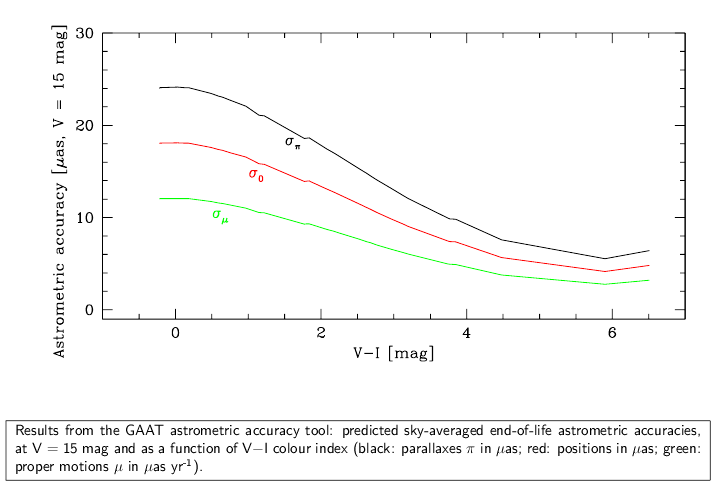
Radial velocities
-
GIAI will measure
radial velocities, probably from Ca II lines in the near IR (8700 Å)
at 1Å/pixel.
-
100-150 individual spectra collected
over circa 5 years.
-
Radial velocities to V = 15
should be +/- 3 km/s.
-
Limit for radial velocities
is approx V=17 (+/- 10 km/s)
-
Slitless grating spectrograph
Photometry
-
Photometric measurements in
broad band filters and low resolution spectroscopy in the optical region.
Major measurement objectives
of GAIA
Note: the expected accuracies (Feb 2009) have been reduced by up to a
factor of 2 from these targets (see figure above).
| |
Parameter |
GAIA Objectives |
| Astrometry |
positional
accuracy
parallax accuracy
proper motion accuracy |
10 microarcsecond at V=15
10 microarcsecond per year
at V=15
10 microarcsecond per year
at V=15 |
| Photometry |
multi-colour
multi-epoch |
4 broad-band + low resolution spectra
(=>intermediate band colours)
accuracy about 0.01 mag
throughout the mission |
| Radial velocity |
velocity accuracy |
1 km/s at V=15, limit at
V=17 |
Measurement goals of GAIA
compared with Hipparcos
| |
Hipparcos |
GAIA |
| Magnitude limit |
about 12 |
21 |
| Completeness |
7.3-9.0 |
19-20 |
| Number of objects |
120000 |
35 million (to
V=15) |
| |
|
350 million
(to V=18) |
| |
|
1.3 billion
(to V=20) |
| Accuracy |
1-2mas |
4 microarcsec
(V=10) |
| |
|
10 microarcsec
(V=15) |
| |
|
0.2 milliarcsec
(V=20) |
| Observing list |
needed a priori |
on-board/unbiased |
Current Status
-
Accepted by ESA as Cornerstone
mission, to fly end of 2011 (last update Feb 2009)
Science Goals
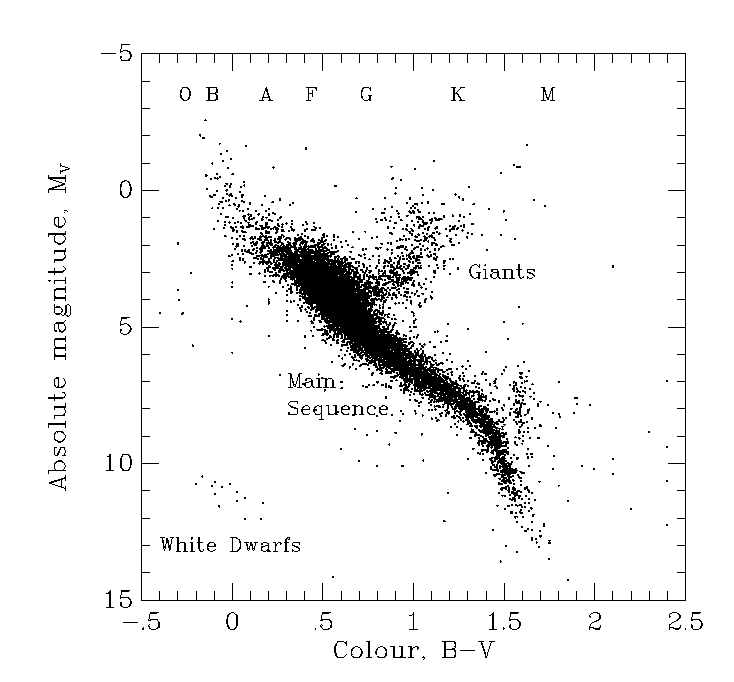 Colour Magnitude of nearby stars produced
by HIPPARCOS
Colour Magnitude of nearby stars produced
by HIPPARCOS
-
Hipparcos' distance horizon
is circa 100 pc (distances of 10% accuracy)
-
GAIA's distance horizon will
be typically 5 kpc with 10% accuracy, 10 kpc with 20% accuracy
-
Primary goals will therefore
be Galactic structure and the physical calibration of stellar luminosity
of a huge range of stellar types
-
Huge numbers of O+B stars, luminous
giants, Cepheids, and RR Lyrae variables all of which are important for
the Cosmic distance scale.
-
First extensive network of distance
measurements throughout a significant fraction of our Galaxy, including
the galactic centre, spiral arms, the halo, and the bulge.
Massive stars
-
No good parallaxes have ever
been measured for O stars, which play an important role in Galactic evolution.
Large numbers will be within 1 kpc, so GAIA will calibrate their luminosities.
Proper motions of O stars in the outer disk will constrain the Galaxy's
rotation curve.
Novae and nova-like variables
-
Distances are currently quite
uncertain for this type of star. Many should be available brighter than
16th (some will occur during the mission and reach V=12) necessary to provide
distances to better than 5 per cent.
Planetary nebulae

-
PN are useful distance indicators
since they can be found in both spiral and elliptical galaxies.
-
Distances of PN within the Galaxy
are presently extremely poorly known, with uncertainties of more than 50%.
-
Parallax measurements of the
central stars would lead to significant advance in the understanding of
the formation and evolution of the shells, the status of the central stars,
and the role of these objects as standard candles.
-
Many tens of planetary nebulae
would be measurable down to V=16 mag.
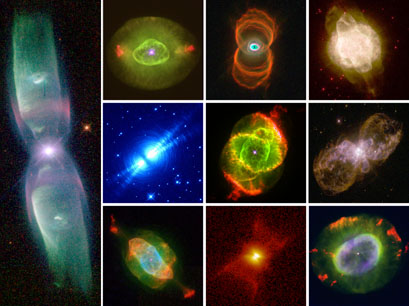
Selection of Planetary Nebulae observed with the HST
Cepheids and RR Lyrae stars
-
In addition to the importance
of these stars to models of stellar structure and evolution, Cepheids and
RR Lyrae form the cornerstone of the extragalactic distance scale.
-
Some 55 Cepheids and 26 RR Lyrae
stars are known to lie within about 1000 pc
-
Parallaxes at the 20 microarcsecond
level would yield distance estimates to better than 2 per cent for these
objects. In turn, the details of the period-luminosity-colour relationship
for these objects would be significantly improved.
Stars in Open Clusters
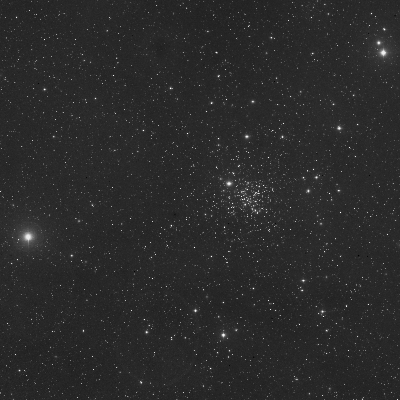
The open cluster M67
-
Only two open clusters (Hyades
and Coma Ber) lie within the 100 pc distance horizon yielding distances
from Hipparcos (from individual objects within the clusters) to better
than 10 per cent accuracy.
-
Some 30 open clusters are considered
to lie within about 500 pc, sufficient to provide individual distances
to 1 per cent accuracy with parallaxes measured at the 20 microarcsecond
level.
-
Full 3-D velocities will be
measurable for many individual cluster members.
-
Cluster studies are probably
most important for stellar physics studies (large population of co-eval
stars).
-
studies of their internal 3-D
dynamical behaviour
-
direct resolution of stellar
evaporation into the field
-
calibration of stellar luminosities
and distances via the Wilson-Bappu effect
-
calibration of the mass-luminosity
relation for binary stars
-
calibration of the main sequence
luminosity as a function of age, helium content, and metallicity.
-
tidal distortion and signatures
for encounters with giant molecular clouds
Globular clusters
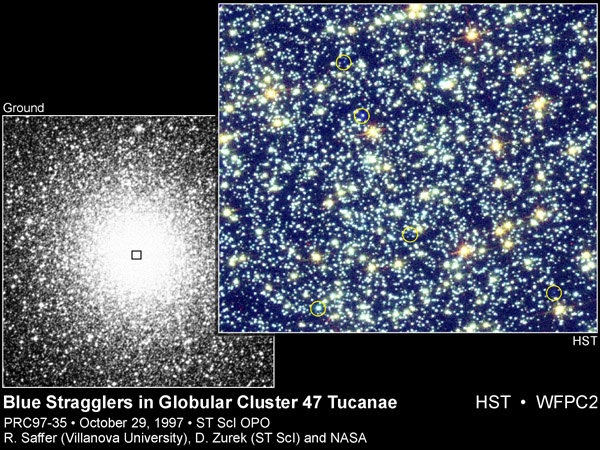
-
Ages of globular clusters:
cluster age determinations require
calibrations of the main-sequence and, in particular, the turn-off point
as a function of chemical composition.
-
For absolute ages to be accurate
to a billion years, the
distance of the cluster must be determined with an accuracy of better than
3 per cent.
-
15 mag and 20 microarcsecond
accuracy on the parallaxes includes 20 or more globular clusters (such
as 47 Tuc, omega Cen, M3, M5, and M15) lying between 5 and 10 kpc, and
would yield individual distances accurate to better than 10 to 20 per cent.
-
Some 10 or more of the brightest
stars per cluster would be observable, resulting in mean cluster distances
at least a factor of three better than these individual accuracies.
-
3-D positions and 3-D velocities
for most of the globular clusters will allow their orbits to be determined
--- dark matter in the Galaxy
-
Within 47 Tucanae, for example,
proper motions of 20 microarcseconds per year correspond to transverse
velocities of 0.4 km per second.
-
3-D velocities should be reconstructible
at the level of a few km/s leading to models of the velocity distribution
function, orbital families of stars and mass models of the cluster
-
In addition, spectroscopic binaries
have been detected in globular clusters with amplitudes of tens of km per
second and periods of years, corresponding to separations of order 1 mas.
These should be imaged directly by GAIA.
-
Parallaxes and annual proper
motions at the level of 50 microsecond or better would provide distances
and orbital data necessary to clarify the formation and evolution of these
binary systems, and their role in the formation of the milli-second pulsars
now known to exist in the cores of globular clusters.
Stellar diameters
-
Many nearby giant stars will
be resolved --- measure radius and hence fundamental astrophysics
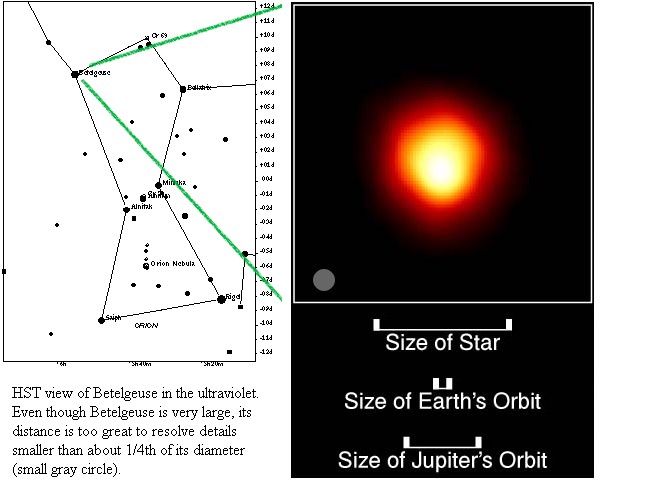
Detection of Planetary Systems
and Brown Dwarfs
-
For a 1 solar mass primary,
at a distance of (say) 10 pc, the perturbation caused by a Jupiter-sized
planet has an amplitude of 500 microarcsecond and a period of 5 years,
while the effect of an the Earth is a one-year period with 0.3 microarcsecond
amplitude.
-
GAIA specs sufficient to detect
Jupiter-mass planets (at the 3 sigma level) out to 30pc, i.e. there are
several thousand potential target stars, all of which can be monitored
for possible companions.
-
for 2 microarcsecond astrometry,
which may be feasible for bright stars (V<10 mag), then the detection
horizon for Jupiter-mass planets is pushed beyond 100 pc. Screening
all 50 million stars down to the survey limit of V=15 to 16 mag for possible
signatures of planetary and brown dwarf companions will provide a complete
census of such bodies to well-defined detection limits.
-
find several 1000 free floating
young brown dwarfs within 15 pc
Star formation
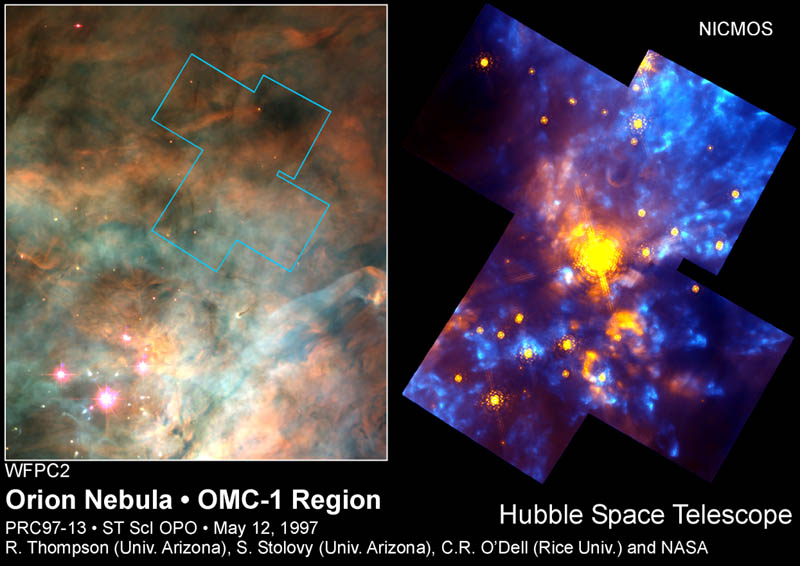
-
luminosities of pre-main sequence
stars
-
kinematics of star forming regions
-
detection of rapid evolutionary
phases
-
background light in emission
line regions is a challange
-
Any high proper motion HII regions
--- formed around 106 solar mass black hole dark matter?
White dwarfs
-
detection of some 300,000 disk
white dwarfs and some 3000 halo white dwarfs in 6-D space
-
reconstruction of the star formation
history of the milky way
-
calibration of white dwarf cooling
sequences
-
age of the disk/halo from WD
LF
-
link to supernaove type Ia ---
how many "loaded guns"?
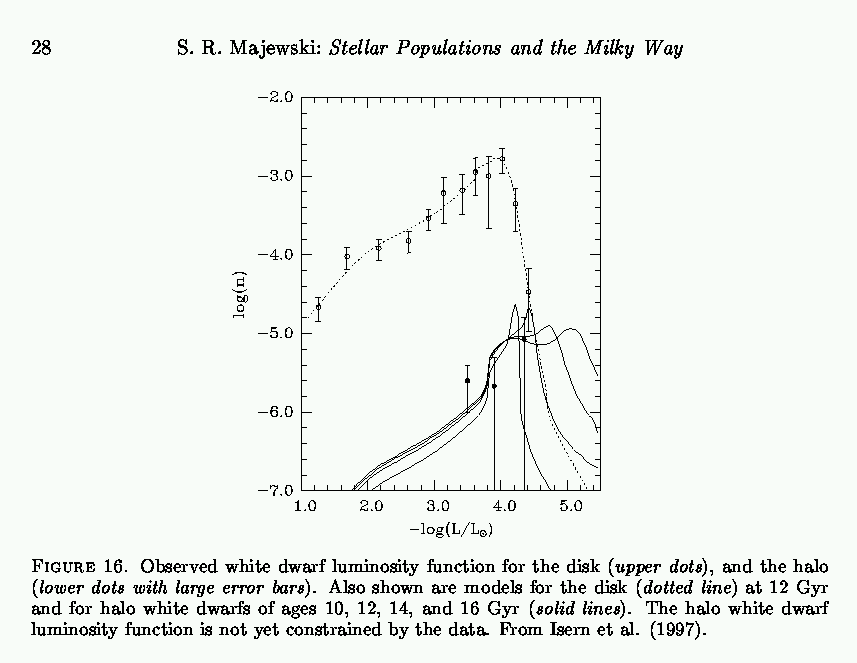
Metal-poor stars and primordial
nucleosynthesis
-
Light element abundances in
halo stars are important constraints on the production of these elements
in the big bang.
-
Large number of halo stars within
1 kpc will be accurate enough to determine surface gravities and light
elemental abundances
-
GAIA will recover millions of
halo stars within 10 kpc with full 3-D positions and velocities.
Visual and astrometric binaries
-
GAIA will resolve binaries with
an apparent separation exceeding 1-2 mas and a moderate magnitude difference
leading to absolute orbits and individual component masses.
-
This will establish with very
high precision the stellar luminosity to mass function.
-
As many as half of the stars
seen could be "binaries" and need special analysis of the photocenters
Interacting binary systems
-
Many interacting binaries accessible
with parallaxes in the 10 to 20 microarcsecond range.
-
The evolutionary history of
interacting binary systems, and the origin of Type I supernovae, millisecond
pulsars, low mass x-ray binaries, and globular cluster x-ray sources is
intimately bound up with the behavior of compact binaries with mass transfer
and loss.
-
accurate knowledge of the stellar
masses and orbital separation can be derived from astrometric measurements
(yielding the orbital separation and the orbital inclination) combined
with estimates of the mass function determined by radial velocity measurements.
-
address specific questions about
accretion rates, precursors, mass distributions, and kinematic behaviour
-
studies of black hole candidates
(Galactic black hole candidates have bright secondaries --- 9 mag
in the case of Cyg X-1, and 12 mag or fainter in the case of V404 Cyg)
and wide orbits (with orbital periods of about 6 days), which should yield
definitive black hole masses by determining orbital separation and inclination.
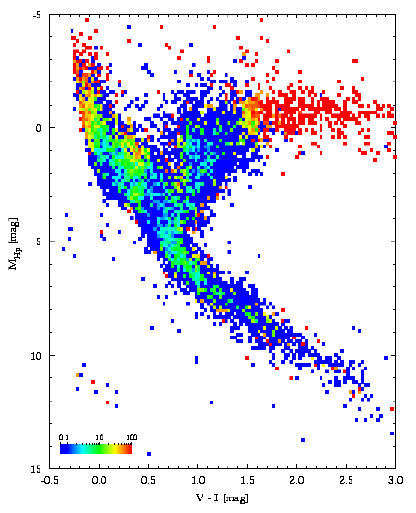
The fraction of
variable stars in the Hipparcos CMD. Stars in blue regions are rarely variable,
whereas stars in the reddest regions are almost all variable. The code at the
bottom of the plot shows the colour which indicates the fraction of stars which
are variable.
Extragalactic Astrophysics and
General Relativity
Proper motions of the Magellanic
Clouds
-
Different explanations for the
dynamical behaviour of the LMC/SMC, in particular whether these systems
are gravitationally bound to our own galaxy, implies systematic proper
motions of below around 1 mas per year, very much at the limit of the Hipparcos
capabilities. Large numbers of stars measured in the LMC/SMC at the level
of 50 microarcsecond or better, would clarify their dynamical relationship
with our own Galaxy.
Local Group Galaxies
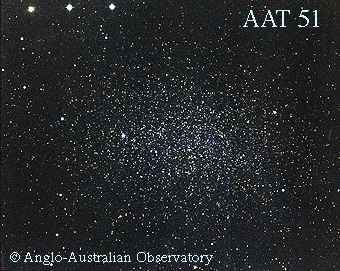 |
-
Direct detection of the proper
motion and rotation curves of local group galaxies
-
Internal kinematics of nearby
dwarf galaxies
-
Galaxy orbits to give cosmological
histories
|
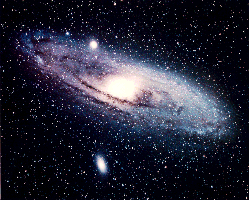
|
Galaxies and active galactic
nuclei
-
Further out, the nuclei of active
galaxies are sufficiently pointlike that their absolute proper motions
may be measurable. At a redshift of z=0.03, a transverse velocity of 1000
km per second corresponds to a proper motion of 3 microsecond per year.
The role of quasars
-
By reaching 15 to 16 mag GAIA
would include a number of quasars, and this in turn would allow a direct
tie between the resulting reference system and an inertial reference frame,
something which has not been possible (directly) in the case of Hipparcos.
-
A few 1000 quasars should be
measured --- microarcsecond optical maps of QSOs --- superluminal motion
maps from several hundred images over 5 years?
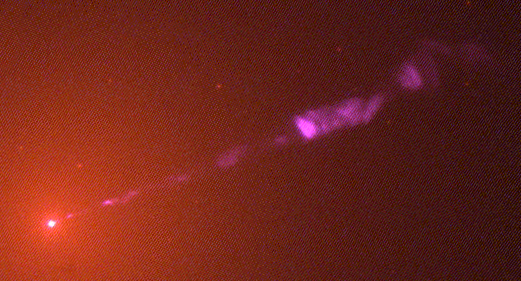
Light-bending by the Sun and
Earth
-
The reduction of the Hipparcos
data has necessitated the inclusion of stellar aberration up to terms in
(v/c)2, and the general relativistic treatment of light bending
due to the gravitational field of the Sun (and Earth).
-
Light bending by the Sun amounts
to 4 mas even at 90° (i.e., for light arriving perpendicular to the
ecliptic).
-
The astrometric residuals may
be tested for discrepancies with general relativity's predictions;
in principle this provides a constraint on the post-Newtonian light-bending
term, γ, which is equal to unity in general relativity.
-
The GAIA measurements would
provide a precision of about 1 part in 106 or better in the
determination of γ due to the Sun.
Higher-order gravitational effects
-
At the level of accuracy expected
from GAIA, even more subtle effects will start to become apparent, such
as the quadrupole components of the gravitational fields of the Sun and
the planets, and the `frame-dragging' effects of their motions and rotations.
MACHOS
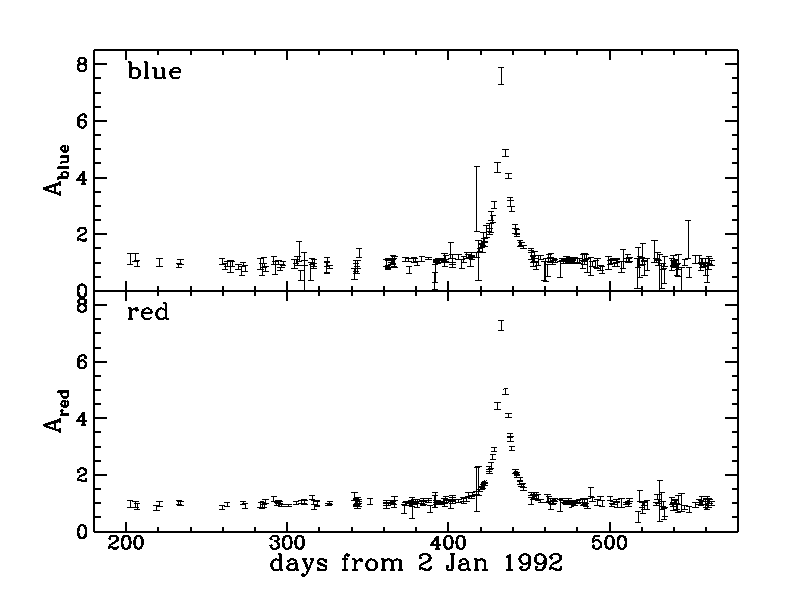
Light curve detected by the MACHO experiment of a star in the LMC,
caused by microlensing by a dark body in the Galactic halo
-
Light modulation effects due
to gravitational lensing by MACHOs, and the possible metric perturbations
due to gravitational waves, must also be considered.
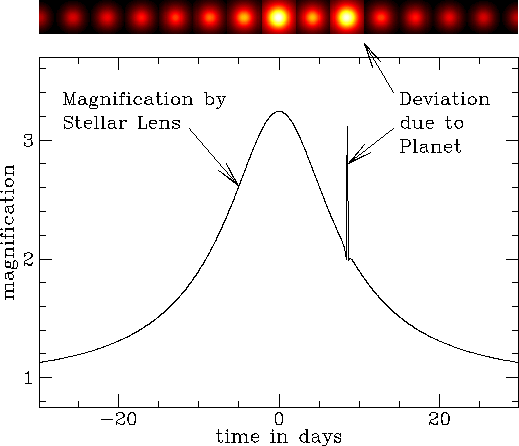
Microlensing by a planet around a faint star,
microlensing a bright background star.
-
Amongst a few hundred million
stars within 1 kpc a significant microlensing rate is expected.
-
Expect circa 1000 microlensing
detections toward the bulge --- probes the stellar mass function at low mass
Dynamics and Evolution of the
Galaxy
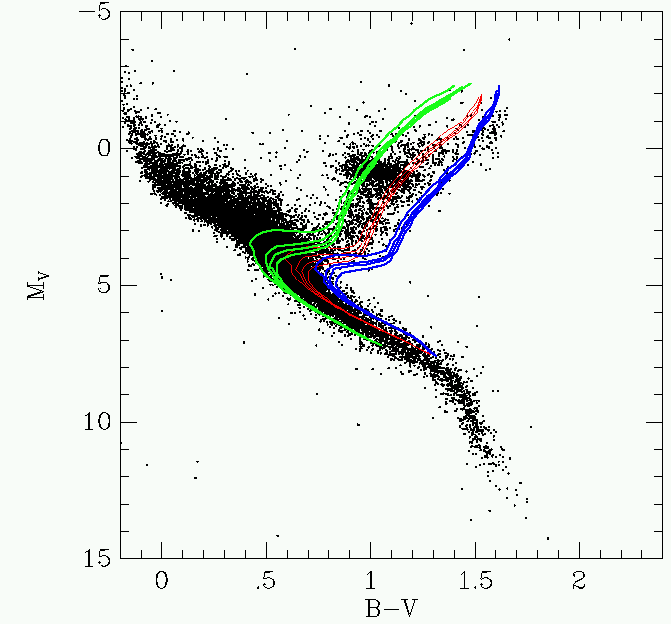
Different isochrones as a function of metallicity plotted on the CMD
produced by HIPPARCOS, which allow the structure of the
main sequence to be determined and the age of the Galaxy to be measured.
-
Tens of millions of G and K
dwarfs will be visible within 1 kpc with measurable [Fe/H], Teff,
log(g).
-
Full 3-D space velocities at
<1 km/s resolution
-
discover and map all the nearby
spiral arms
-
considerable phase space structure
should be resolvable i..e moving groups or star streams,
motions of stars across spiral arms --- weigh the spiral arms
-
Photometry will be
used to measure the [Fe/H] distribution of metallicity as a function
of position in the Galactic disk --- constrain evolutionary models of the
gas into stars
-
complete census of the solar
neighbourhood will give a superbly determined stellar luminosity function
--- reducing to hugely the major uncertainty in converting star counts
to models of Galactic structure
-
star formation history via directly
determined ages for millions of F and G type stars, within 2 kpc (!) of the sun
-
role of giant molecular clouds
and spiral waves in "heating" the Galactic disk (Age-velocity relation).
-
determination of the outer disk
rotation curve
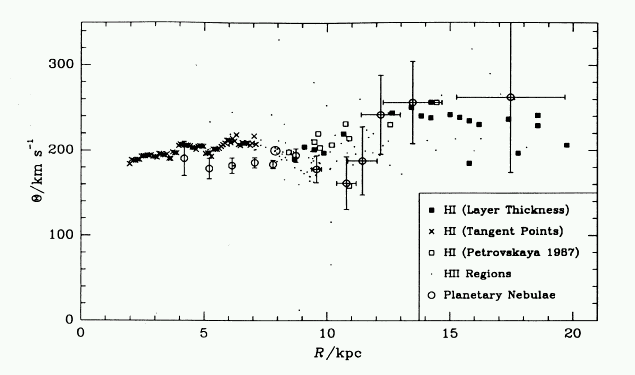
Rotation curve of the
Milky Way. The curve shows the circular rotation rate of stars and gas in the
disk as a function of distance from the Galactic center. The "flatness" of this
curve (rotation speed is the same at all radii) is a major piece of evidence
for dark matter in the Galaxy.
-
disk mass profile -- amount
of matter in the disk within a radius of circa 1 kpc, amount of "graininess"
in the matter distribution
-
role of mergers in Galactic
history
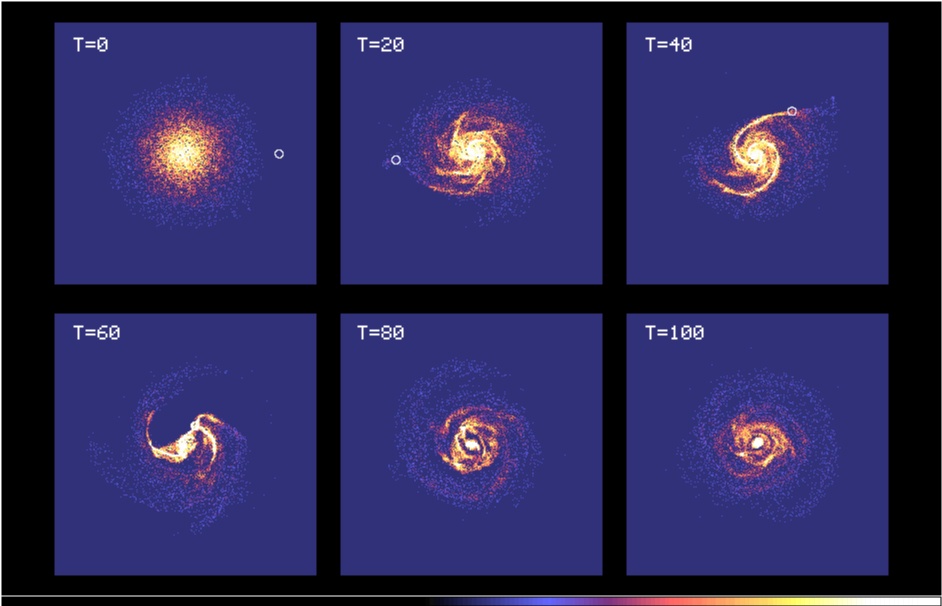
Simulation of a small galaxy merging with a massive disk galaxy.
-
balance between vertical kinetic
energy of stellar populations and the disk potential
-
bulge/bar kinematics and inner
disk structure
-
distance to the Galactic center
-
kinematics of the outer disk
warp
Galactic Halo
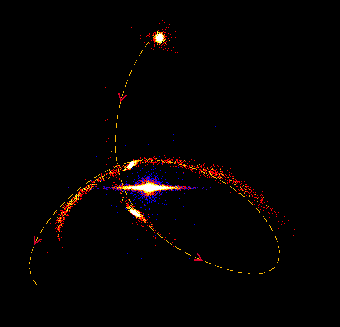 |
Simulation of a satellite
being accreted by the Milky Way. It leaves behind a trail of stars which
GAIA should be able to find, if they exist. Many such satellite accretions
are expected during the early life of the Milky Way, and continue up to
the present time. Source: Johnston et.al. www.sns.ias.edu/~kvj/ |
-
Satellite systems which have
been accreted by the Galaxy probably leave behind tidal "streamers" in
the halo. Finding and tracing these yields information about the accretion
process and the dark matter distribution.
-
the number and mass of these
systems (especially in the outer halo) will test hierarchial models of
the formation of galaxies (e.g. CDM)
Pulsars
-
some pulsars may be detectible,
pulsar companions in general detectible --- yields distances and luminosities
of pulsars
Cosmology
-
GAIA will fill in the gap the
"corellation function", between Microwave Background measurements
and ground based galaxy
surveys (like APM) by uniform detection of galaxies over wide areas
-
Supernovae --- during the 5
year mission approx 50,000 supernovae will be detected out to z =0.10.
--- accurate distances to large numbers of galaxies from light curves and
measurement of deviations of the Hubble flow from redshifts (ground based
followup probably needed)
Solar System Bodies
-
Expect to detect 105
- 106 new asteroids
-
Near Earth Objects may be detected
(uncertain)
-
~2000 resolved asteroids? depends
on movement during CCD crossing
Summary of tracers
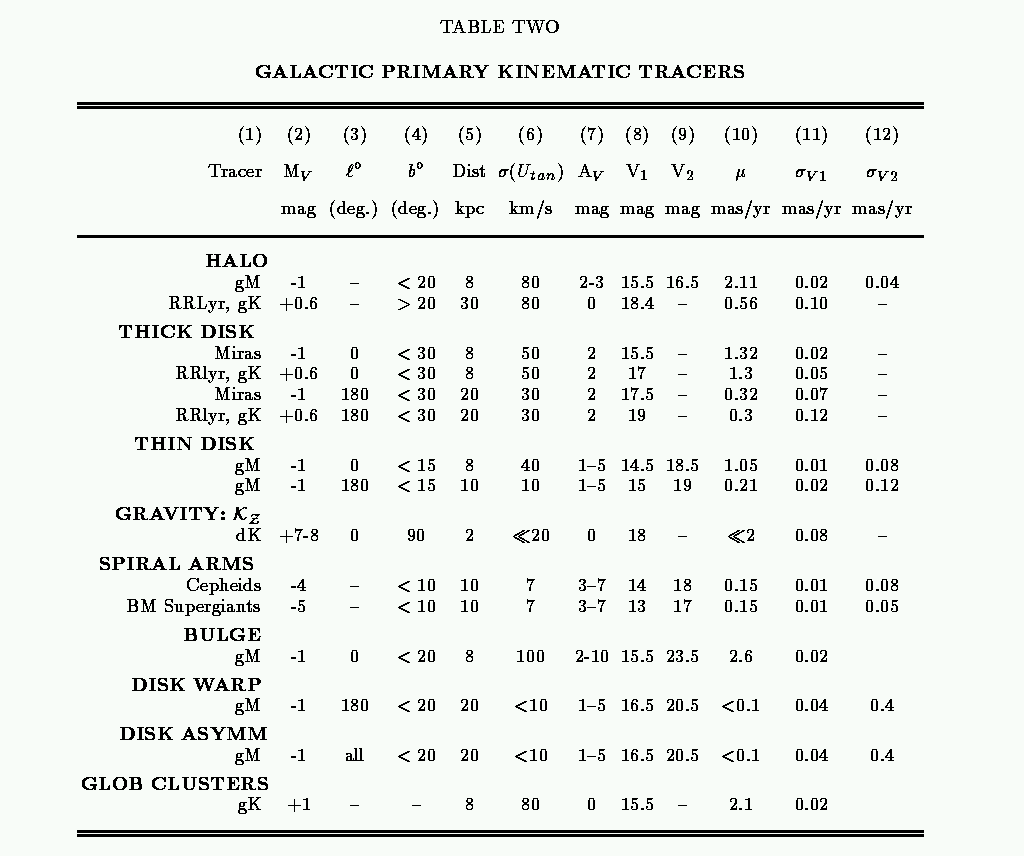

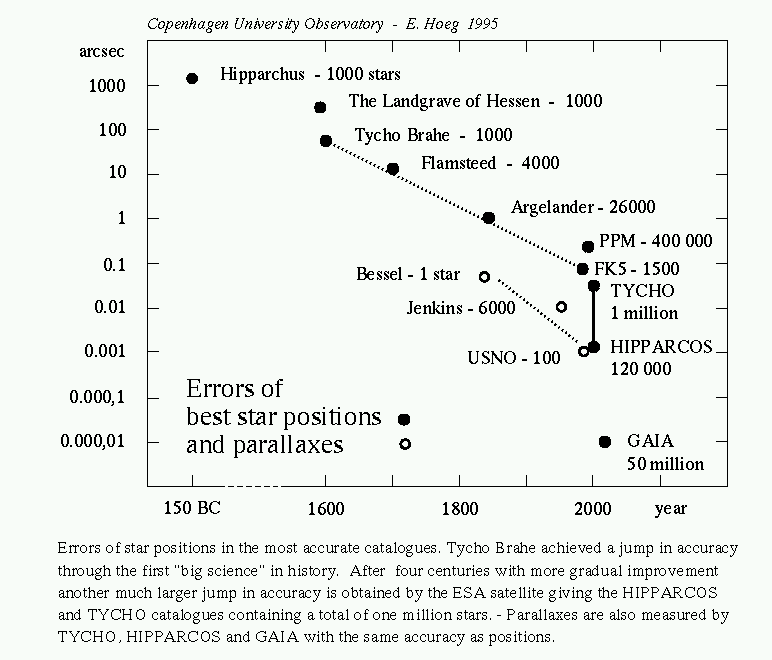
Primary reference:
GAIA
website

















